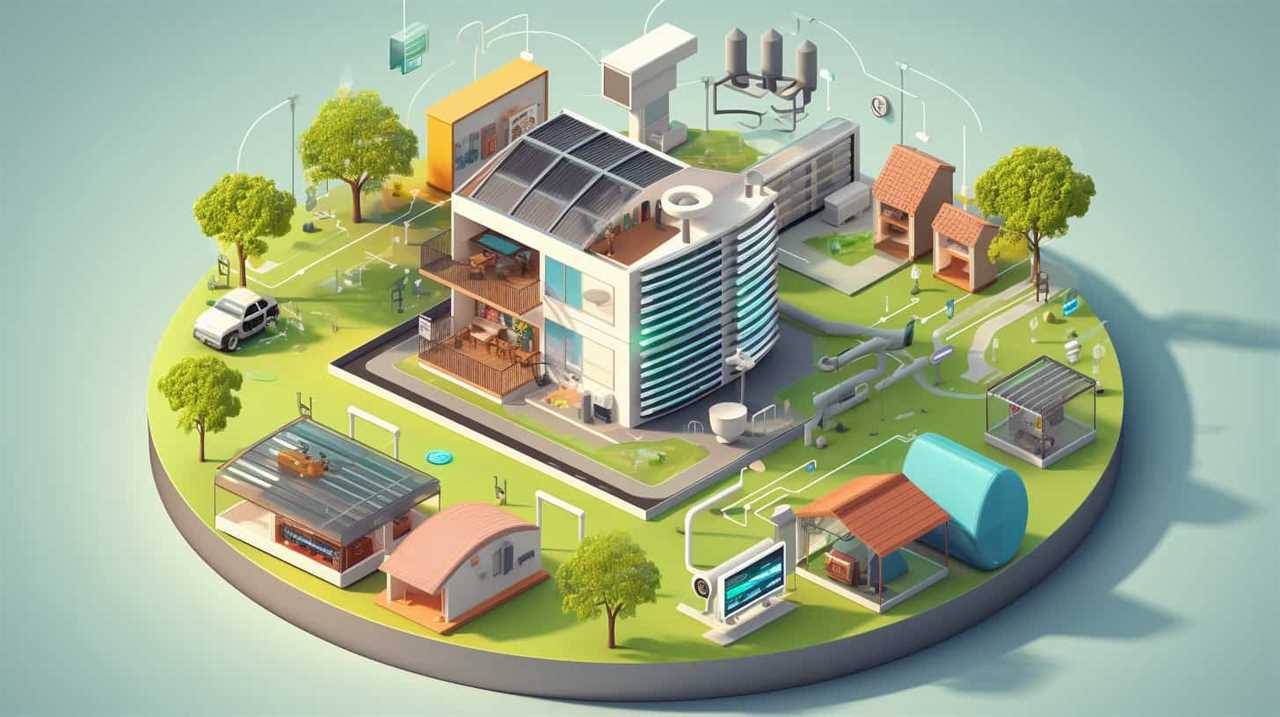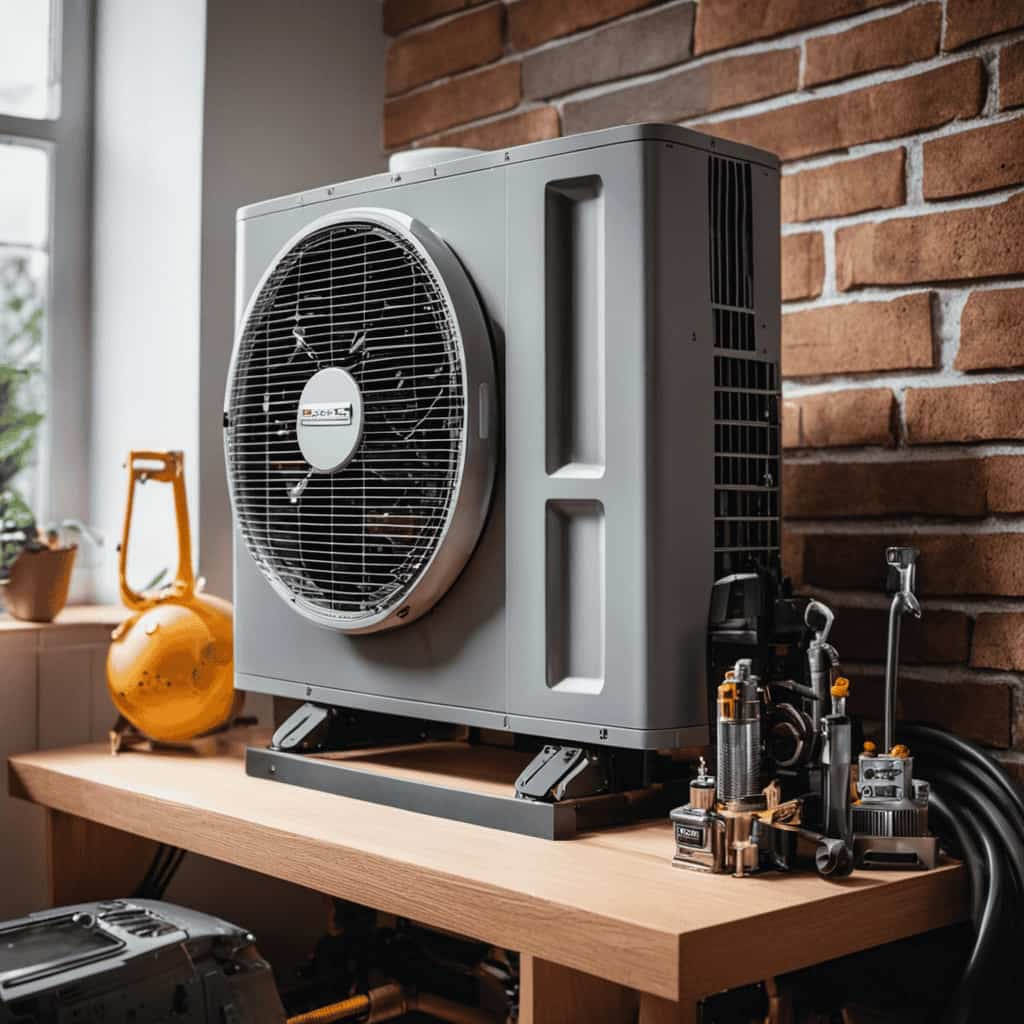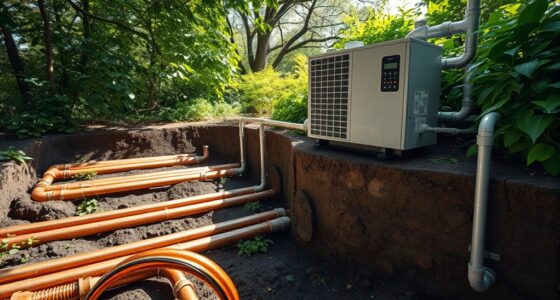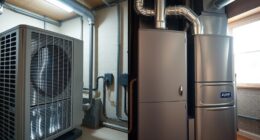Have you considered the costs associated with geothermal heat pumps, despite their well-known benefits? Our comprehensive installation guide delves into the financial aspect to give you a clear idea of what to expect in terms of expenses.
From the initial investment to potential energy savings, we explore the ins and outs of geothermal heat pump installation. Assessing equipment costs, labor expenses, and available incentives, we provide the data-driven insights you need to make informed decisions.
Let’s dive into the world of geothermal heat pump costs and savings.
Key Takeaways
- Geothermal heat pump initial investment ranges from $10,000 to $30,000, depending on factors such as home size and installation complexity.
- Labor and installation expenses can vary based on the complexity of the installation and the need for drilling or excavation work.
- Geothermal heat pumps provide significant energy savings of up to 70% compared to traditional systems, resulting in lower energy bills and reduced environmental impact.
- Incentives and rebates, such as federal tax credits and state/local incentives, can offset the initial investment and make geothermal heat pump systems more affordable.
Understanding the Initial Investment
We’ll break down the initial investment for a geothermal heat pump to help you understand the costs involved. When evaluating return, it’s important to consider the various options available and compare them to find the most cost-effective solution.

The initial investment includes the cost of the heat pump unit itself, as well as installation costs and any necessary modifications to your property. On average, the initial investment for a geothermal heat pump ranges from $10,000 to $30,000, depending on factors such as the size of your home and the complexity of the installation.
However, it’s important to remember that while the upfront costs may be higher than traditional heating and cooling systems, the long-term energy savings and environmental benefits can outweigh the initial investment.
Moving forward, let’s dive into evaluating equipment and material costs for your geothermal heat pump installation.
Evaluating Equipment and Material Costs
When evaluating equipment and material costs for geothermal heat pump installation, it’s important to consider the price variations of different equipment options and the potential impact on the overall project budget. Factors such as brand reputation, energy efficiency ratings, and system capacity can all contribute to variations in equipment prices.

Additionally, material costs, including piping, fittings, and insulation, should be carefully evaluated to ensure they meet the project requirements while staying within budget constraints.
Equipment Price Variations
Our research has revealed significant variations in equipment prices for geothermal heat pump installations. When evaluating equipment and material costs, it’s essential to consider several cost factors and conduct thorough price comparisons. Here are two key aspects to keep in mind:
Equipment Type:
Ground Source Heat Pumps (GSHPs): These systems utilize buried pipes to extract heat from the ground. They tend to have higher upfront costs due to the excavation and installation requirements.

Water Source Heat Pumps (WSHPs): These systems extract heat from a water source, such as a well or lake. They may have lower initial costs, but additional expenses might be incurred for water access.
System Size:
The size of the heat pump system is determined by the heating and cooling capacity needed for your space. Larger systems tend to have higher equipment costs but can provide greater efficiency and comfort.
Material Cost Considerations
To accurately assess the cost of materials, we must carefully evaluate equipment and material costs for a geothermal heat pump installation. When considering material costs, it’s essential to prioritize energy-efficient materials that will optimize the performance of the heat pump system.

These materials may include high-quality pipes, insulation, and geothermal loops. Investing in energy-efficient materials upfront can result in long-term cost savings by reducing energy consumption and maximizing the efficiency of the system.
Additionally, the installation process plays a significant role in material cost considerations. Factors such as the size and layout of the property, accessibility, and ground conditions can impact the quantity and type of materials required for the installation.
Proper evaluation of equipment and material costs is crucial for a successful and cost-effective geothermal heat pump installation.
Assessing Labor and Installation Expenses
We frequently consider labor and installation expenses when assessing the costs of geothermal heat pump installation. These expenses can vary depending on several factors, including the complexity of the installation and the efficiency of the labor involved.

When it comes to geothermal heat pump installation challenges, some common issues can arise. These can include the need for extensive drilling or excavation work, which can increase both labor and equipment costs. Additionally, the installation of underground loops can require specialized knowledge and skills, further adding to the labor expenses.
To ensure labor and installation efficiency, it’s crucial to hire experienced professionals who are familiar with geothermal heat pump systems. Proper planning and coordination are also key to minimizing installation time and maximizing efficiency.
Exploring Potential Energy Savings
When considering the installation of a geothermal heat pump, it’s important to explore the potential energy savings that can be achieved.
Geothermal systems have proven to be highly cost-effective, offering significant long-term financial benefits.

Cost-Effectiveness of Geothermal
Exploring the cost-effectiveness of geothermal heat pumps can reveal potential energy savings for homeowners. By implementing geothermal systems, homeowners can enjoy significant cost saving measures and reduce their environmental impact. Here are some key points to consider:
Lower energy bills: Geothermal heat pumps can provide up to 70% energy savings compared to traditional heating and cooling systems. This translates into significant cost savings for homeowners in the long run.
Increased efficiency: Geothermal systems utilize renewable energy from the ground, which is more efficient than burning fossil fuels. This reduces the overall environmental impact and carbon footprint of a household.
Long lifespan: Geothermal heat pumps have an average lifespan of 20-25 years, which is longer than traditional systems. This means fewer replacements and maintenance costs over time.

Incentives and rebates: Many governments and utility companies offer incentives and rebates for installing geothermal systems, further enhancing the cost-effectiveness of these systems.
Calculating Potential Energy Savings
By utilizing a geothermal heat pump system, homeowners can potentially save a significant amount of energy and reduce their utility bills. But how do you calculate the actual energy savings? To estimate the potential energy consumption and payback period of a geothermal heat pump system, several factors need to be considered. These include the size of the home, the local climate, the efficiency of the system, and the cost of electricity. By taking these factors into account, homeowners can get a better understanding of the potential energy savings they can expect.
To illustrate this, let’s take a look at a hypothetical example. In the table below, we compare the estimated energy consumption and potential savings of a conventional HVAC system with a geothermal heat pump system.
| Conventional HVAC System | Geothermal Heat Pump System | |
|---|---|---|
| Annual Energy Consumption (kWh) | 10,000 | 6,000 |
| Annual Energy Savings (kWh) | – | 4,000 |
| Payback Period (years) | – | 5 |
In this example, the geothermal heat pump system saves 4,000 kWh of energy per year compared to the conventional HVAC system. With an estimated payback period of 5 years, homeowners can see the long-term energy and cost savings potential of investing in a geothermal heat pump system.

Long-Term Financial Benefits
We can maximize our long-term financial benefits by considering the potential energy savings of a geothermal heat pump system. Investing in a geothermal heat pump can lead to significant energy cost reductions over time, resulting in substantial savings.
When exploring the environmental impact of geothermal heat pumps, it’s crucial to analyze the return on investment. Here are two key points to consider:
Energy Efficiency: Geothermal heat pumps are highly efficient, utilizing renewable energy from the ground to heat and cool our homes. This results in lower energy consumption and reduced utility bills.
Longevity: Geothermal heat pump systems have a lifespan of 20 to 25 years, which means long-term cost savings and minimal maintenance expenses compared to traditional heating and cooling systems.

Investigating Available Incentives and Rebates
The available incentives and rebates can greatly reduce the overall cost of installing a geothermal heat pump. When considering the cost effectiveness of a geothermal heat pump system, it’s important to explore the various incentives and rebates that are available.
These incentives can come in the form of tax credits, grants, or rebates from utility companies. For example, the federal government offers a 26% tax credit for the installation of a geothermal heat pump system. Additionally, some state and local governments also provide incentives to encourage the adoption of geothermal heat pumps.
These incentives can significantly offset the initial investment and make geothermal heat pump systems more affordable. It’s recommended to research and take advantage of all available incentives and rebates to maximize cost savings during installation.
Considering Long-Term Maintenance and Operating Costs
To accurately assess the overall cost-effectiveness of a geothermal heat pump system, we must carefully consider the long-term maintenance and operating costs.

When evaluating the long-term maintenance benefits of a geothermal heat pump system, it’s important to note that these systems require minimal maintenance compared to conventional heating and cooling systems. The underground components of the system, such as the heat exchanger and pipes, are built to last for decades without the need for frequent repairs or replacements.
Additionally, the operating costs of geothermal heat pump systems are significantly lower compared to traditional heating and cooling systems. This is due to the fact that geothermal systems utilize the constant temperature of the earth to provide efficient heating and cooling, resulting in reduced energy consumption and lower utility bills.
Frequently Asked Questions
How Long Does It Typically Take to Recoup the Initial Investment of Installing a Geothermal Heat Pump?
It typically takes several years to recoup the initial investment of installing a geothermal heat pump. However, due to the high geothermal heat pump efficiency, the payback period can be significantly shorter than other heating and cooling systems.
Are There Any Additional Costs or Fees Associated With Obtaining Permits or Licenses for Geothermal Heat Pump Installation?
Yes, there can be additional costs and fees associated with obtaining permits and licenses for geothermal heat pump installation. These may include permit costs and licensing fees, which should be factored into the overall budget.

What Factors Should I Consider When Evaluating the Energy Efficiency of Different Geothermal Heat Pump Models?
When evaluating the energy efficiency of different geothermal heat pump models, we consider factors such as the Coefficient of Performance (COP), Energy Efficiency Ratio (EER), and Seasonal Energy Efficiency Ratio (SEER). Comparing these metrics helps us determine which models are the most efficient.
Are There Any Specific Qualifications or Certifications I Should Look for in a Geothermal Heat Pump Installer?
When considering a geothermal heat pump installer, it is important to look for specific qualifications and certifications. These include geothermal heat pump installer qualifications and geothermal heat pump installation certifications.
Can I Expect Any Increase in My Property Value After Installing a Geothermal Heat Pump?
Yes, installing a geothermal heat pump can potentially increase your property value. Studies have shown that homeowners can expect a return on investment ranging from 50% to 100% when selling their property.
What Are Some Uncovered Costs Associated with Geothermal Heat Pump Installation?
Geothermal heat pump installation costs often go beyond the initial investment. Some commonly overlooked expenses include drilling or excavation, loop system installation, and electrical upgrades. Additionally, homeowners might incur charges for permits, inspections, and system maintenance. It’s crucial to consider these uncovered costs to accurately plan and budget for geothermal heat pump installation.
Conclusion
In conclusion, delving into the costs of geothermal heat pump installation reveals a symphony of financial considerations.

From the initial investment and equipment costs to labor expenses and potential energy savings, it’s crucial to carefully weigh the pros and cons.
Additionally, investigating available incentives and rebates and considering long-term maintenance and operating costs will ensure a harmonious balance between cost and efficiency.
By embracing the rhythm of informed decision-making, we can orchestrate a sustainable and cost-effective geothermal heating system.









